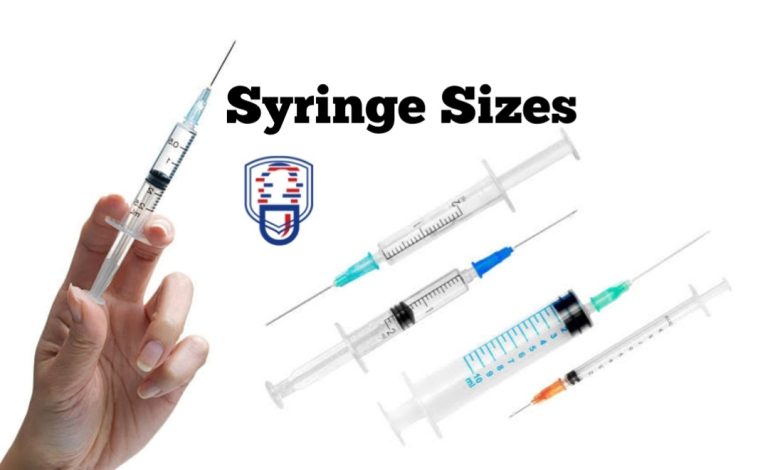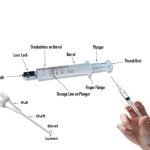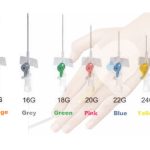5 Syringe Sizes and Their Functions

What is a syringe?
A syringe is a medical device that is used for injecting or withdrawing fluids from the body. It is an essential tool for healthcare providers in a wide range of medical procedures, from administering vaccinations and insulin injections to taking blood samples and delivering intravenous drugs.
The basic structure of a syringe consists of three parts: a cylindrical barrel, a plunger, and a needle. The barrel is the long, thin tube that holds the fluid or gas that is being injected or withdrawn. The plunger is the piston-like mechanism that fits snugly inside the barrel and is used to push the fluid or gas out or draw it in. The needle is the sharp, thin, and hollow tube that attaches to the end of the barrel and penetrates the skin to deliver the fluid or gas into the body.
The needle of a syringe is another important component. Needles come in various sizes and gauges, with the gauge referring to the thickness of the needle. The larger the gauge, the thinner the needle. The size and gauge of the needle are important because they determine how much pain or discomfort the patient will experience during the injection or withdrawal. Thicker needles are more painful than thinner needles and larger needles can cause more damage to the tissue than smaller needles.
Functions Of a Syringe
Syringes are used for a variety of medical procedures, including vaccinations, insulin injections, blood tests, and intravenous drug delivery. In vaccinations, a small amount of a weakened or dead virus or bacteria is injected into the body to stimulate the immune system and build immunity against the disease. Insulin injections are used to manage diabetes by delivering insulin directly into the bloodstream. Blood tests are performed to diagnose various medical conditions and involve withdrawing a small amount of blood from a vein. Intravenous drug delivery involves delivering drugs directly into the bloodstream through a vein.
Syringes are also used in emergency situations, such as during cardiac arrest or allergic reactions. In these cases, medications are delivered quickly and directly into the body through a syringe to provide immediate relief or support.
The proper use and disposal of syringes are important to prevent the spread of infection and ensure safe and effective medical procedures. Healthcare providers must follow strict protocols for handling and disposing of syringes to prevent contamination and infection. Disposable syringes should be discarded in special containers that are designed to prevent accidental needle sticks and protect healthcare workers from exposure to blood-borne pathogens.
What are the 5 common sizes of syringes?
The most common syringe sizes are 1mL, 2mL, 5mL, 10mL, and 20mL. The size of the syringe determines the amount of fluid that can be delivered or withdrawn at one time. Smaller syringes are used for injecting medications, while larger syringes are used for withdrawing bodily fluids or delivering intravenous drugs. The functions of the various sizes of syringes are:
- 1mL syringes: These is the smallest syringes available and is primarily used for administering small doses of medication or vaccines. They are commonly used in pediatric medicine, where doses need to be precise and small. 1mL syringes are also used for subcutaneous injections, where medication is injected into the fatty tissue just under the skin.
- 2mL syringes: These are also used for administering small doses of medication or vaccines but are slightly larger than 1mL syringes. They are commonly used in adult medicine for administering intramuscular injections, where the medication is injected into the muscle tissue.
- 5mL syringes: This type of syringe is larger and can deliver larger doses of medication or vaccines. They are commonly used for intramuscular injections, where the medication is injected into the muscle tissue, or subcutaneous injections, where the medication is injected into the fatty tissue under the skin.
- 10mL syringes: The 10ml syringes are larger in size when compared to the 5ml. They are primarily used for withdrawing fluids from the body, such as blood or urine, for diagnostic purposes. They are also used for delivering intravenous medications or fluids.
- 20mL syringes: These are the largest syringes available and are used for withdrawing large amounts of fluid from the body or delivering intravenous medications or fluids. They are commonly used in emergency situations, where a patient needs a large amount of medication or fluid quickly.
In addition to the standard sizes, there are also specialty syringes available for specific medical procedures. Insulin syringes, for example, are designed for administering insulin to diabetic patients and come in various sizes, including 0.3mL, 0.5mL, and 1mL. Tuberculin syringes are used for administering small doses of medication for tuberculosis testing and come in sizes ranging from 0.5mL to 1mL.
The gauge of the needle also affects the size of the syringe. The gauge refers to the thickness of the needle, with a higher gauge indicating a thinner needle. Thinner needles are less painful than thicker needles and are commonly used for administering vaccines or other medications. Thicker needles are used for withdrawing fluids from the body, such as blood or urine, for diagnostic purposes.
It is important to note that the size of the syringe and the gauge of the needle used depend on the medical procedure being performed. Healthcare providers must determine the appropriate syringe size and needle gauge for the patient and the medication being administered or withdrawn.
In addition to the size of the syringe and the gauge of the needle, the type of syringe used is also important. There are two types of syringes: disposable and reusable. Disposable syringes are designed for single use only and are discarded after use. They are made of plastic and are cheaper than reusable syringes. Reusable syringes can be sterilized and used multiple times, and they are made of glass or stainless steel. Reusable syringes are more durable and can last for years with proper care, but they are more expensive than disposable syringes.
The decision to use disposable or reusable syringes depends on the medical facility’s policies and procedures and the type of medical procedure being performed. Disposable syringes are preferred for procedures that require a high degree of sterility, such as injections or vaccinations. Reusable syringes are preferred for procedures that require multiple injections or that require the syringe to be reused, such as in laboratory research.
Conclusion
In conclusion, syringes come in various sizes, each designed for specific medical procedures. The most common syringe sizes are 1mL, 2mL, 5mL, 10mL, and 20mL. The size of the syringe determines the amount of fluid that can be delivered or withdrawn at one time. The gauge of the needle also affects the size of the syringe, with a higher gauge indicating a thinner needle. Healthcare providers must determine the appropriate syringe size and needle gauge for the patient and the medication being administered or withdrawn.
The decision to use disposable or reusable syringes depends on the medical facility’s policies and procedures and the type of medical procedure being performed. Both disposable and reusable syringes have their advantages and disadvantages, and healthcare providers must weigh these factors when selecting the appropriate type of syringe for a specific medical procedure.
Overall, the correct selection of syringe size and type is critical in ensuring that patients receive safe and effective medical care. By understanding the different syringe sizes and types available, healthcare providers can make informed decisions and ensure that patients receive the best possible care.




